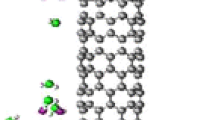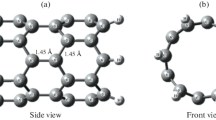Abstract
Single-walled carbon nanotube (SWCNT) functionalized with Pd nanoclusters have been shown experimentally to be effective H2S gas sensors. To this end, we have modeled a field-effect transistor with semiconducting SWCNT functionalized with palladium nanoclusters as the channel. Using non-equilibrium Green’s function method combined with density functional theory, we have investigated the effect of Pd nanoclusters on the electrical properties of the device and the sensing ability of the device as an H2S gas sensor at zero bias voltage. We have modeled two devices, one with Au electrodes and the other with SWCNT electrodes to show the effect of Au electrodes on the electrical properties of the device. In order to analyze the reason for the changes in the electrical properties of the device, charge transfer and electrostatic potential of the system are investigated. Results show that in both devices, functionalization with Pd nanoclusters results with the accumulation of charge on the channel while H2S adsorption causes charge depletion in the channel. In all cases, both charge transfer and electrostatic gating are responsible for the changes in the charge-carrier concentration in the channel. Due to significant changes in the electrical properties of the device after H2S adsorption, detection is possible with high sensitivity.

Graphical abstract















Similar content being viewed by others
Data availability
All data generated or analyzed during this study are included in this published article.
References
Alaie MM, Jahangiri M, Rashidi AM, Asl AH, Izadi N (2015) A novel selective H2S sensor using dodecylamine and ethylenediamine functionalized graphene oxide. Ind Eng Chem 29:97–103
Asad M, Sheikhi MH, Pourfath M, Moradi M (2015) High sensitive and selective flexible H2S gas sensors based on Cu nanoparticle decorated SWCNTs. Sensors Actuators B Chem 210:1–8
Ashori E, Nazari F, Illas F (2014) Adsorption of H2S on carbonaceous materials of different dimensionality. Int J Hydrog Energy 39:6610–6619
Bagherzadeh-Nobari S, Kalantarinejad R, Elahi SM, Sanvito S (2018) Computational investigation of label free detection of biomolecules based on armchair graphene nanoribbon. Sensors Actuators B Chem 255:1276–1284
Bagherzadeh-Nobari S, Hosseini Istadeh K, Kalantarinejad R (2020) Computational modelling of an amide functionalized single-walled carbon nanotube based H2S gas sensor. Phys E Low-dimens Syst Nanostruct 115:113691
Basu S, Bhattacharyya P (2012) Recent developments on graphene and graphene oxide based solid state gas sensors. Sensors Actuators B Chem 173:1–21
Berahman M, Sheikhi MH (2015) Hydrogen sulfide gas sensor based on decorated zigzag graphene nanoribbon with copper. Sensors Actuators B Chem 219:338–345
Brooks BR, Bruccoleri RE, Olafson BD, States DJ, Swaminathan SA, Karplus M (1983) CHARMM: a program for macromolecular energy, minimization, and dynamics calculations. J Comput Chem 4:187–217
Cao C, Kemper AF, Agapito L, Zhang JW, He Y, Rinzler A, Cheng HP, Zhang XG, Rocha AR, Sanvito S (2009) Nonequilibrium Green’s function study of Pd4 -cluster-functionalized carbon nanotubes as hydrogen sensors. Phys Rev B 79:075127
Chandran GT, Li X, Ogata A, Penner RM (2017) Electrically transduced sensors based on nanomaterials (2012–2016). Anal Chem 89:249–275
Cho S, Lee JS, Jun J, Kim SG, Jang J (2014) Fabrication of water-dispersible and highly conductive PSS-doped PANI/graphene nanocomposites using a high-molecular weight PSS dopant and their application in H2S detection. Nanoscale 6:15181–15195
Chou CH, World Health Organization (2003) Hydrogen sulfide: human health aspects. World Health Organization
Fam DWH, Tok AIY, Palaniappan A, Nopphawan P, Lohani A, Mhaisalkar SG (2009) Selective sensing of hydrogen sulphide using silver nanoparticle decorated carbon nanotubes. Sensors Actuators B Chem 138:189–192
Gilbert JC, Nocedal J (1992) Global convergence properties of conjugate gradient methods for optimization. SIAM J Optim 2:21–42
Hu N, Wang Y, Chai J, Gao R, Yang Z, ESW K, Zhang Y (2012) Gas sensor based on p-phenylenediamine reduced graphene oxide. Sensors Actuators B Chem 163:107–114
Hu N, Yang Z, Wang Y, Zhang L, Wang Y, Huang X et al (2013) Ultrafast and sensitive room temperature NH3 gas sensors based on chemically reduced graphene oxide. Nanotechnology 25:025502
Huang X, Hu N, Gao R, Yu Y, Wang Y, Yang Z et al (2012) Reduced graphene oxide–polyaniline hybrid: preparation, characterization and its applications for ammonia gas sensing. J Mater Chem 22:22488–22495
Humphrey W, Dalke A, Schulten K (1996) VMD: visual molecular dynamics. J Mol Graph 14:33–38
Kalantari-Nejad R, Bahrami M, Rafii-Tabar H, Rungger I, Sanvito S (2010) Computational modeling of a carbon nanotube-based DNA nanosensor. Nanotechnology 21:445501
Kolmakov A, Moskovits M (2004) Chemical sensing and catalysis by one-dimensional metal-oxide nanostructures. Annu Rev Mater Res 34:151–180
Li K, Wang W, Cao D (2011) Metal (Pd, Pt)-decorated carbon nanotubes for CO and NO sensing. Sensors Actuators B Chem 159:171–177
Li X, Zhao Y, Wang X, Wang J, Gaskov AM, Akbar SA (2016) Reduced graphene oxide (rGO) decorated TiO2 microspheres for selective room-temperature gas sensors. Sensors Actuators B Chem 230:330–336
Llobet E, Brunet J, Pauly A, Ndiaye A, Varenne C (2017) Nanomaterials for the selective detection of hydrogen sulfide in air. Sensors 17:391
Lu G, Yu K, Ocola LE, Chen J (2011) Ultrafast room temperature NH3 sensing with positively gated reduced graphene oxide field-effect transistors. Chem Commun 47:7761–7763
Lu J, Zhang X, Wu X, Dai Z, Zhang J (2015) A Ni-doped carbon nanotube sensor for detecting oil-dissolved gases in transformers. Sensors 15:13522–13532
Meng FL, Guo Z, Huang XJ (2015) Graphene-based hybrids for chemiresistive gas sensors. TrAC Trends Anal Chem 68:37–47
Moon S, Vuong NM, Lee D, Kim D, Lee H, Kim D et al (2016) Co3O4–SWCNT composites for H2S gas sensor application. Sensors Actuators B Chem 222:166–172
Mubeen S, Zhang T, Chartuprayoon N, Rheem Y, Mulchandani A, Myung NV, Deshusses MA (2010) Sensitive detection of H2S using gold nanoparticle decorated single-walled carbon nanotubes. Anal Chem 82:250–257
Phillips JC, Braun R, Wang W, Gumbart J, Tajkhorshid E, Villa E et al (2005) Scalable molecular dynamics with NAMD. J Comput Chem 26:1781–1802
Rani S, Kumar M, Garg R, Sharma S, Kumar D (2016) Amide functionalized graphene oxide thin films for hydrogen sulfide gas sensing applications. IEEE Sensors J 16:2929–2934
Rocha AR, Garcia-Suarez VM, Bailey SW, Lambert CJ, Ferrer J, Sanvito S (2005) Towards molecular spintronics. Nat Mater 4:335–339
Rocha AR, García-Suárez VM, Bailey S, Lambert C, Ferrer J, Sanvito S (2006) Spin and molecular electronics in atomically generated orbital landscapes. Phys Rev B 73:085414
Rungger I, Sanvito S (2008) Algorithm for the construction of self-energies for electronic transport calculations based on singularity elimination and singular value decomposition. Phys Rev B 78:035407
Russell J, Zapol P, Král P, Curtiss LA (2012) Methane bond activation by Pt and Pd subnanometer clusters supported on graphene and carbon nanotubes. Chem Phys Lett 536:9–13
Russo PA, Donato N, Leonardi SG, Baek S, Conte DE, Neri G, Pinna N (2012) Room-temperature hydrogen sensing with heteronanostructures based on reduced graphene oxide and tin oxide. Angew Chem Int Edit 51:11053–11057
Shanthi K, Balasubramanian N (1996) A simple spectrophotometric method for the determination of hydrogen sulfide based on Schiff's reaction. Microchem J 53:168–174
Star A, Joshi V, Skarupo S, Thomas D, Gabriel JCP (2006) Gas sensor array based on metal-decorated carbon nanotubes. J Phys Chem B 110:21014–21020
Toda K, Furue R, Hayami S (2015) Recent progress in applications of graphene oxide for gas sensing: a review. Anal Chim Acta 878:43–53
Wang Y, Zhang L, Hu N, Wang Y, Zhang Y, Zhou Z et al (2014) Ammonia gas sensors based on chemically reduced graphene oxide sheets self-assembled on Au electrodes. Nanoscale Res Lett 9:251
Wang T, Huang D, Yang Z, Xu S, He G, Li X et al (2016) A review on graphene-based gas/vapor sensors with unique properties and potential applications. Nano-Micro Lett 8:95–119
Xiao H, Li SH, Cao JX (2009) First-principles study of Pd-decorated carbon nanotube for hydrogen storage. Chem Phys Lett 483:111–114
Yang W, Gan L, Li H, Zhai T (2016) Two-dimensional layered nanomaterials for gas-sensing applications. Inorg Chem Front 3:433–451
Yoo R, Kim J, Song MJ, Lee W, Noh JS (2015) Nano-composite sensors composed of single-walled carbon nanotubes and polyaniline for the detection of a nerve agent simulant gas. Sensors Actuators B Chem 209:444–448
Zhang X, Dai Z, Wei L, Liang N, Wu X (2013) Theoretical calculation of the gas-sensing properties of Pt-decorated carbon nanotubes. Sensors 13:15159–15171
Zhang X, Gui Y, Dai Z (2014) A simulation of Pd-doped SWCNTs used to detect SF6 decomposition components under partial discharge. Appl Surf Sci 315:196–202
Zhou L, Shen F, Tian X, Wang D, Zhang T, Chen W (2013) Stable Cu2O nanocrystals grown on functionalized graphene sheets and room temperature H2S gas sensing with ultrahigh sensitivity. Nanoscale 5:1564–1569
Author information
Authors and Affiliations
Corresponding author
Ethics declarations
Conflict of interest
The authors declare that they have no conflict of interest.
Code availability
Smeagol code is used in this publication that is available free of charge for researchers belonging to the academic community.
Additional information
Publisher’s note
Springer Nature remains neutral with regard to jurisdictional claims in published maps and institutional affiliations.
Rights and permissions
About this article
Cite this article
Bagherzadeh-Nobari, S., Istadeh, K.H. & Kalantarinejad, R. Computational modeling of transport properties of decorated SWCNT: application in H2S gas sensor. J Nanopart Res 22, 289 (2020). https://doi.org/10.1007/s11051-020-05013-3
Received:
Accepted:
Published:
DOI: https://doi.org/10.1007/s11051-020-05013-3




